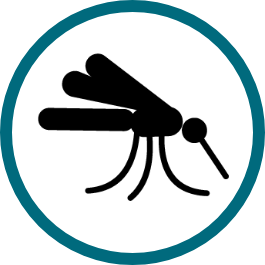Intermittent preventive treatment of malaria in pregnancy reduces incidence of low birth weight by 29%, severe maternal anemia by 38% and neonatal mortality by 31%. This is a periodic behavior that needs to be practiced at every ANC visit.1Investing in Malaria in Pregnancy in Sub-Saharan Africa: Saving Womens and Childrens Lives

Intermittent Preventive Treatment of Malaria in Pregnancy
Pregnant women take intermittent preventive treatment of malaria (IPTp) during antenatal care (ANC) visits
Key Points from Global Research
- Pregnant women’s knowledge about the protective benefits of IPTp for herself and her unborn child coupled with provider skill on correct timing and dosing can contribute to an increase in this cost-effective and easily administered intervention beginning in the second trimester.
Behavior Profile Sample: Intermittent Preventive Treatment of Malaria in Pregnancy
A Behavior Profile is a summary analysis of each behavior. This sample draws from global evidence and illustrates the result of using the Create Behavior Profiles Tool to analyze factors, supporting actors and strategies and to ensure logical pathways exist between strategies proposed and factors related to the practice of the behavior. This sample may be used as a starting point or reference for creating Behavior Profiles.
| Improve maternal and child survival | |
|
Pregnant women take intermittent preventive treatment of malaria (IPTp) during antenatal care (ANC) visits Indicator: Percentage of women age 15-49 with a live birth in the two years preceding the survey who during the pregnancy took 3 or more doses of SP/Fansidar, with at least one dose during an antenatal care visit
Indicator: Percentage of women age 15-49 with a live birth in the two years preceding the survey who during the pregnancy took 2 or more doses of SP/Fansidar, with at least one dose during an antenatal care visit |
Behavior Analysis |
Strategy | ||
|---|---|---|---|
STEPSWhat steps are needed to practice this behavior?
Click on any box |
FACTORSWhat factors may prevent or support practice of this behavior? These should be analyzed for each country context.StructuralAccessibility: Pregnant women cannot access SP because the SP or related commodities are unavailable Service Provider Competencies: Pregnant women do not receive SP at each visit because providers do not have the proper technical information to adhere to national MIP guidelines SocialFamily and Community Support: Pregnant women do not seek SP because it is not promoted or encouraged by community-based community health volunteers or agents Family and Community Support: IPTp is seldom endorsed or promoted by community-based service providers InternalAttitudes and Beliefs: Pregnant women refuse SP because they fear the side effects Attitudes and Beliefs: Pregnant women do not adhere to provider instructions because they do not understand the difference between drug-based prevention and treatment Knowledge: Pregnant women do not obtain SP or adhere to provider’s instructions because they are unaware of the benefits of SP for themselves and their unborn children |
SUPPORTING ACTORS AND ACTIONSWho must support the practice of this behavior?InstitutionalPolicymakers: Incorporate IPTp into broader reproductive health programs in collaboration with MIP point of contact and reproductive health staff Providers: Administer SP appropriately during ANC visits Providers: Counsel about protective benefits, timing and dosing of IPTp to all pregnant women and their partners Logistics Personnel: Procure sufficient stock of SP or other IPTp commodity supplies Managers: Seek innovative ways to provide client-friendly services closer and more convenient to the client Managers: Conduct regular supportive supervisory visits with facility-based service providers to ensure proper administration of and counseling for IPTp CommunityCommunity Leaders: Create or support structures that promote social accountability to encourage community-based service providers to promote the benefits of IPTp as part of ANC services Community and Religious Leaders: Engage men and male heads of households to support the decision of pregnant women to seek ANC especially in the absence of community-based service provider support |
POSSIBLE PROGRAM STRATEGIESHow might we focus our efforts based on this analysis?Enabling EnvironmentPartnerships and Networks: Encourage delivery of ANC and IPTp in non-formal settings, such as through NGOs and by community health workers directly in the community to ensure that ANC is accessible to all women Policies and Governance: Integrate IPTp into reproductive health programs to ensure that all women accessing these services receive IPTp Policies and Governance: Create or leverage the power and influence of existing community leaders and members to advocate for accountability at health facilities Systems, Products and ServicesSupply Chain: Strengthen commodities and supply chain for Fansidar/SP or IPTp protocol at all levels to ensure adequate stock for the recommended minimum number of doses per expected pregnant woman Quality Improvement: Disseminate to providers clear IPTp guidelines and information to use in counseling women on benefits to ensure that all women are receiving recommended IPTp during ANC Quality Improvement: Expand and promote services offered during ANC to increase women’s perceived value of IPTp Quality Improvement: Equip health workers with relevant, locally tailored behavior-centered job aids to provide better IPTp services to women Demand and UseCommunication: Use appropriate communication approaches to promote value of preventative services to mother and unborn child Communication: Exploit direct-to-consumer digital tools, such as mobile technologies, interactive voice response (IVR), etc. to reach women directly to convey benefits of and value for IPTp as part of routine ANC visits |
Global Status of Accelerator Behavior
Indicator: Percentage of women age 15-49 with a live birth in the two years preceding the survey who during the pregnancy took 3 or more doses of SP/Fansidar, with at least one dose during an antenatal care visit
Malaria Indicator Survey, The DHS Program Indicator Data API, The Demographic and Health Surveys (DHS) Program


 The Manoff Group was acquired by JSI in 2022.
The Manoff Group was acquired by JSI in 2022.